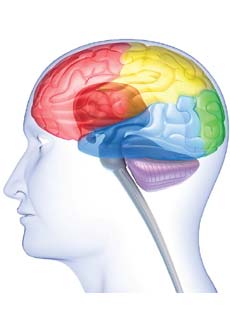|
|
Cerebral Venous Sinus Thrombosis: A rare and Uncommon Medical Condition
 Cerebral
venus sinus thrombosis (CVST) occurs when a blood clot forms in the brain�s
venous sinuses that prevents blood from draining out of the brain. As a result,
blood cells may break and leak blood into the brain tissues, forming a
hemorrhage. This chain of events is part of a stroke that can occur in adults
and children, even in newborns and babies in the womb. A stroke can result in
damage to the brain and central nervous system. A stroke is serious and requires
immediate medical attention. This condition may also be called cerebral
sinovenous thrombosis. Cerebral
venus sinus thrombosis (CVST) occurs when a blood clot forms in the brain�s
venous sinuses that prevents blood from draining out of the brain. As a result,
blood cells may break and leak blood into the brain tissues, forming a
hemorrhage. This chain of events is part of a stroke that can occur in adults
and children, even in newborns and babies in the womb. A stroke can result in
damage to the brain and central nervous system. A stroke is serious and requires
immediate medical attention. This condition may also be called cerebral
sinovenous thrombosis.
Cerebral
venous sinus thrombosis (CVST) is the presence of thrombosis (a blood clot) in
the dural venous sinuses, which drain blood from the brain. Symptoms may include
headache, abnormal vision, any of the symptoms of stroke such as weakness of the
face and limbs on one side of the body, and seizures. The diagnosis is usually
by computed tomography (CT/CAT scan) or magnetic resonance imaging (MRI)
employing radiocontrast to demonstrate obstruction of the venous sinuses by
thrombus.
Treatment is with anticoagulants (medication that suppresses blood clotting),
and rarely thrombolysis (enzymatic destruction of the blood clot). Given that
there is usually an underlying cause for the disease, tests may be performed to
look for these. The disease may be complicated by raised intracranial pressure,
which may warrant surgical intervention such as the placement of a shunt. There
are several other terms for the condition, such as cerebral venous and sinus
thrombosis, (superior) sagittal sinus thrombosis, dural sinus thrombosis and
intracranial venous thrombosis as well as the older term cerebral
thrombophlebitis.
Facts about venous sinus thrombosis
CVST is a rare form of stroke. It affects about five people in 1 million
each year. The risk for this kind of stroke in newborns is greatest during the
first month. Overall, about three out of 300,000 children and teens up to age 18
will have a stroke.Children and adults have different risk factors for CVST.
Risk factors for children and infants include:
-
Pregnancy and peripartum
-
Problems with blood clotting; for example, antiphospholipid syndrome,
protein C and S deficiency, antithrombin III deficiency, lupus
anticoagulant, or factor V Leiden mutation
Cancer
-
Collagen vascular diseases like lupus, Wegener�s granulomatosis, and
Behcet syndrome
-
Obesity
-
Intracranial hypotension
-
Inflammatory bowel disease like Crohn�s disease or ulcerative colitis
Symptoms
Nine in ten people with sinus thrombosis have a headache; this tends to
worsen over the period of several days, but may also develop suddenly
(thunderclap headache). The headache may be the only symptom of cerebral venous
sinus thrombosis. Many patients have symptoms of stroke: inability to move one
or more limbs, weakness on one side of the face or difficulty speaking. This
does not necessarily affect one side of the body as in the more common
"arterial" stroke.
40% of all patients have seizures, although it is more common still in women who
develop sinus thrombosis peripartum (in the period before and after giving
birth). These are mostly seizures affecting only one part of the body and
unilateral (occurring on one side), but occasionally the seizures are
generalised and rarely they lead to status epilepticus (persistent or recurrent
seizure activity for a long period of time).
In the elderly, many of the aforementioned symptoms may not occur. Common
symptoms in the elderly with this condition are otherwise unexplained changes in
mental status and a depressed level of consciousness.
The pressure around the brain may rise, causing papilledema (swelling of the
optic disc) which may be experienced as visual obscurations. In severely raised
intracranial pressure, the level of consciousness is decreased, the blood
pressure rises, the heart rate falls and the patient assumes an abnormal
posture.
These are the physical symptoms that may occur:
-
Headache
-
Blurred vision
-
Fainting or loss of consciousness
-
Loss of control over movement in part of the body
-
Seizures
-
Coma
Complications of venous sinus thrombosis include:
-
Impaired speech
-
Difficulty moving parts of the body
-
Problems with vision
-
Headache
-
Increased fluid pressure inside the skull
-
Pressure on nerves
-
Brain injury
-
Developmental delay
-
Death
Diagnosis
 Doctors typically take a medical history and do a physical exam. Family and
friends can describe the symptoms they saw, especially if the person who had the
stroke is unconscious. The final diagnosis, however, is usually made based on
how the blood is flowing in the brain. Imaging tests show areas of blood flow.
These tests may be used to diagnose venous sinus thrombosis: Doctors typically take a medical history and do a physical exam. Family and
friends can describe the symptoms they saw, especially if the person who had the
stroke is unconscious. The final diagnosis, however, is usually made based on
how the blood is flowing in the brain. Imaging tests show areas of blood flow.
These tests may be used to diagnose venous sinus thrombosis:
-
MRI scan
-
CT scan
-
Venography
-
Angiography
-
Ultrasound
-
Blood tests
The diagnosis may be suspected on the basis of the symptoms, for example the
combination of headache, signs of raised intercranial pressure and focal
neurological abnormalities, or when alternative causes of headache and
neurological abnormalities, such as a subarachnoid hemorrhage, have been exclud
CT venogram showing a filling defect in the sagittal sinus
There are various neuroimaging investigations that may detect cerebral sinus
thrombosis. Cerebral edema and venous infarction may be apparent on any
modality, but for the detection of the thrombus itself, the most commonly used
tests are computed tomography (CT) and magnetic resonance imaging (MRI), both
using various types of radiocontrast to perform a venogram and visualise the
veins around the brain.
Computed tomography, with radiocontrast in the venous phase (CT venography or
CTV), has a detection rate that in some regards exceeds that of MRI. The test
involves injection into a vein (usually in the arm) of a radioopaque substance,
and time is allowed for the bloodstream to carry it to the cerebral veins - at
which point the scan is performed. It has a sensitivity of 75-100% (it detects
75-100% of all clots present), and a specificity of 81-100% (it would be
incorrectly positive in 0-19%). In the first two weeks, the "empty delta sign"
may be observed (in later stages, this sign may disappear).
Magnetic resonance venography employs the same principles, but uses MRI as a
scanning modality. MRI has the advantage of being better at detecting damage to
the brain itself as a result of the increased pressure on the obstructed veins,
but it is not readily available in many hospitals and the interpretation may be
difficult.
Cerebral angiography may demonstrate smaller clots than CT or MRI, and
obstructed veins may give the "corkscrew appearance". This, however, requires
puncture of the femoral artery with a sheath and advancing a thin tube through
the blood vessels to the brain where radiocontrast is injected before X-ray
images are obtained. It is therefore only performed if all other tests give
unclear results or when other treatments may be administered during the same
procedure.
D-dimer
A 2004 study suggested that the D-dimer blood test, already in use for the
diagnosis of other forms of thrombosis, was abnormal (above 500 μg/l) in 34 out
of 35 patients with cerebral sinus thrombosis, giving it a sensitivity of 97.1%,
a negative predictive value of 99.6%, a specificity of 91.2%, and a positive
predictive value of 55.7%. Furthermore, the level of the D-dimer correlated with
the extent of the thrombosis. A subsequent study, however, showed that 10% of
patients with confirmed thrombosis had a normal D-dimer, and in those who had
presented with only a headache 26% had a normal D-dimer. The study concludes
that D-dimer is not useful in the situations where it would make the most
difference, namely in lower probability cases.
Further tests
In most patients, the direct cause for the cerebral sinus thrombosis is not
readily apparent. Identifying a source of infection is crucial; it is common
practice to screen for various forms of thrombophilia (a propensity to form
blood clots).
Pathogenesis
The veins of the brain, both the superficial veins and the deep venous system,
empty into the dural venous sinuses, which carry blood back to the jugular vein
and thence to the heart. In cerebral venous sinus thrombosis, blood clots
usually form both in the veins of the brain and the venous sinuses. The
thrombosis of the veins themselves causes venous infarction�damage to brain
tissue due to a congested and therefore insufficient blood supply. This results
in cerebral edema (both vasogenic and cytotoxic edema), and leads to small
petechial haemorrhages that may merge into large haematomas. Thrombosis of the
sinuses is the main mechanism behind the increase in intracranial pressure due
to decreased resorption of cerebrospinal fluid (CSF). The condition does not
lead to hydrocephalus, however, because there is no difference in pressure
between various parts of the brain.
Any blood clot forms due to an imbalance between coagulation (the formation of
the insoluble blood protein fibrin) and fibrinolysis. The three major mechanisms
for such an imbalance are enumerated in Virchow's triad: alterations in normal
blood flow, injury to the blood vessel wall, and alterations in the constitution
of blood (hypercoagulability). Most cases of cerebral venous sinus thrombosis
are due to hypercoagulability.
It is possible for the clot to break off and migrate (embolise) to the lungs,
causing a pulmonary embolism. An analysis of earlier case reports concludes that
this occurs in about 10% of cases, but has a very poor prognosis.
Treatment
 Treatment should begin immediately and must be done in a hospital. A
treatment plan could include: Treatment should begin immediately and must be done in a hospital. A
treatment plan could include:
-
-
Antibiotics, if infections are present
-
Antiseizure medication
-
Monitoring and controlling the pressure inside the head
-
Medication called a coagulant to stop the blood from clotting
-
Surgery
-
Continued monitoring of brain activity
-
Measuring visual acuity and monitoring change
-
Rehabilitation
Various studies have investigated the use of anticoagulation to suppress
blood clot formation in cerebral venous sinus thrombosis. Before these trials
had been conducted, there had been a concern that small areas of hemorrhage in
the brain would bleed further as a result of treatment; the studies showed that
this concern was unfounded. Clinical practice guidelines now recommend heparin
or low molecular weight heparin in the initial treatment, followed by warfarin,
provided there are no other bleeding risks that would make these treatments
unsuitable. Some experts discourage the use of anticoagulation if there is
extensive hemorrhage; in that case, they recommend repeating the imaging after
7�10 days. If the hemorrhage has decreased in size, anticoagulants are
commenced, while no anticoagulants are given if there is no reduction.
The duration of warfarin treatment depends on the circumstances and underlying
causes of the condition. If the thrombosis developed under temporary
circumstances (e.g. pregnancy), three months are regarded as sufficient. If the
condition was unprovoked but there are no clear causes or a "mild" form of
thrombophilia, 6 to 12 months is advised. If there is a severe underlying
thrombosis disorder, warfarin treatment may need to continue indefinitely.
Thrombolysis (removal of the blood clot with "clot buster" medication) has been
described, either systemically by injection into a vein or directly into the
clot during angiography. The 2006 European Federation of Neurological Societies
guideline recommends that thrombolysis is only used in patients who deteriorate
despite adequate treatment, and other causes of deterioration have been
eliminated. It is unclear which drug and which mode of administration is the
most effective. Bleeding into the brain and in other sites of the body is a
major concern in the use of thrombolysis. American guidelines make no
recommendation with regards to thrombolysis, stating that more research is
needed.
Raised intracranial pressure, if severe or threatening vision, may require
therapeutic lumbar puncture (removal of excessive cerebrospinal fluid),
medication (acetazolamide), or neurosurgical treatment (optic nerve sheath
fenestration or shunting). In certain situations, anticonvulsants may be used to
prevent seizures; these are focal neurological problems (e.g. inability to move
a limb) and/or focal changes of the brain tissue on CT or MRI scan.
Prognosis
In 2004 the first adequately large scale study on the natural history and
long-term prognosis of this condition was reported; this showed that at 16
months follow-up 57.1% of patients had full recovery, 29.5%/2.9%/2.2% had
respectively minor/moderate/severe symptoms or impairments, and 8.3% had died.
Severe impairment or death were more likely in those aged over 37 years, male,
affected by coma, mental status disorder, intracerebral hemorrhage, thrombosis
of the deep cerebral venous system, central nervous system infection and cancer.
A subsequent systematic review of nineteen studies in 2006 showed that mortality
is about 5.6% during hospitalisation and 9.4% in total, while of the survivors
88% make a total or near-total recovery. After several months, two thirds of the
cases has resolution ("recanalisation") of the clot. The rate of recurrence was
low (2.8%).
In children with CVST, the mortality averages 50%. Poor outcome is more likely
if a child with CVST develops seizures or has evidence of venous infarction on
imaging.
Prevention
You can do a lot to prevent stroke by leading a heart healthy lifestyle:
-
Eat a low-fat diet including lots of fruits and vegetables.
-
Get daily exercise.
-
Avoid cigarette smoke.
-
Control chronic health conditions, such as diabetes.
Managing after venous sinus thrombosis
What you need to do to recover and then stay healthy after CVST will depend
on how the stroke affected your brain. Everyone can benefit from a healthy diet
and exercise.
You may also need to participate in a special rehabilitation program or physical
therapy if you have lost some movement or speech.
Other possible effects of the stroke, such as headaches or changes in vision,
can be treated by specialists.
If you have had this type of stroke, you may need to avoid certain types of
medications such as oral contraceptives that can increase your risk for blood
clots.
Recent case: Hillary Clinton has cerebral venous thrombosis.
 Hillary Clintons has cerebral venous thrombosis -- is a rare and potentially
"life-threatening" condition, according to medical experts, but one from which
the globe-trotting secretary of state is likely to recover from. In an update
from her doctors, Clinton's brain scans revealed a clot had formed in the right
transverse venous sinus, and she was being successfully treated with
anticoagulants. Hillary Clintons has cerebral venous thrombosis -- is a rare and potentially
"life-threatening" condition, according to medical experts, but one from which
the globe-trotting secretary of state is likely to recover from. In an update
from her doctors, Clinton's brain scans revealed a clot had formed in the right
transverse venous sinus, and she was being successfully treated with
anticoagulants.
"She is lucky being Hillary Clinton and had a follow-up MRI -- lucky that her
team thought to do it," said Dr. Brian D. Greenwald, medical director at JFK
Johnson Rehabilitation Center for Head Injuries. "It could have potentially
serious complications. "The backup of blood flow could have caused a stroke or
hemorrhage, according to Greenwald.
"Imagine this vein, where all the cerebral spinal fluid inside the head and
spine no longer flows through this area," he said. "You get a big back up and
that itself could cause a stroke. In the long-term � the venous system can't get
the blood out of the brain. It's like a Lincoln Tunnel back up."A transverse
sinus thrombosis is a clot arising in one of the major veins that drains the
brain. It is an uncommon but serious disorder.
According to Greenwald, the clot was most likely caused by dehydration brought
on by the flu, perhaps exacerbated by a concussion she recently suffered.
"The only time I have seen it happen is when people are severely dehydrated and
it causes the blood to be so thick that it causes a clot in the area," said
Greenwald. "It's one of the long-term effects of a viral illness."
Drs. Lisa Bardack of the Mt. Kisco Medical Group and Dr. Gigi El-Bayoumi of
George Washington University discovered the clot during a routine follow-up MRI
on Sunday.
"This is a clot in the vein that is situated in the space between the brain and
the skull behind the right ear," they said in a statement today. "It did not
result in a stroke, or neurological damage. To help dissolve this clot, her
medical team began treating the secretary with blood thinners. She will be
released once the medication dose has been established."
Clinton is "making excellent progress," according to her doctors. "She is in
good spirits, engaging with her doctors, her family, and her staff."
Clinton, 65, was hospitalized at New York-Presbyterian Hospital Sunday. She
suffered a concussion earlier this month after she hit her head when she fainted
because of dehydration from a stomach virus, according to an aide.
Dehydration can also precipitate fainting, according to Dr. Neil Martin, head of
neurovascular surgery at University of California, Los Angeles Medical Center.
He agreed that the condition could potentially have caused a brain hemorrhage or
stroke and been fatal.
"In patients with no symptoms after many days, full recovery is the norm," said
Martin. "However, some cases show extension of the thrombus or clot into other
regions of the cerebral venous sinuses, and this can worsen the situation
considerably -- thus the use of anticoagulants to prevent extension of the
thrombus."
But, he said, anticoagulants can be a "double-edged sword." With even a tiny
injury within the brain from the concussion, these medications can cause
"symptomatic bleed," such as a subdural or intracerebral hemorrhage.
The clot location is not related to the nasal sinuses, but are rather large
venous structures in the dura or protective membrane covering the brain, which
drains blood from the brain.
Credits and resources:
Dated 03 January 2013
|
|
|
|
|







